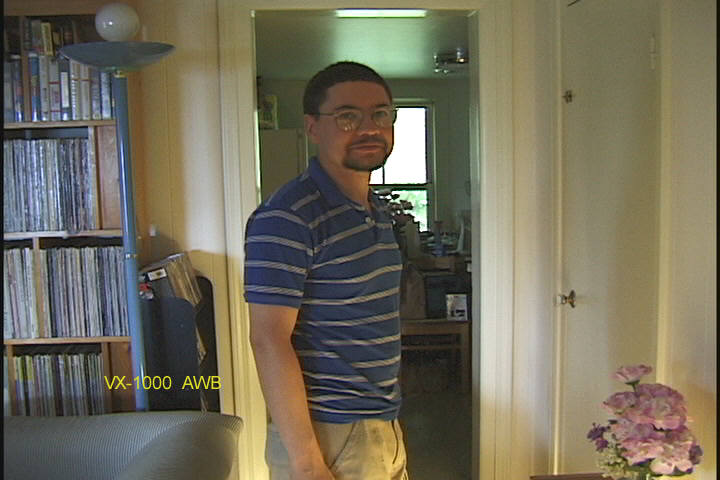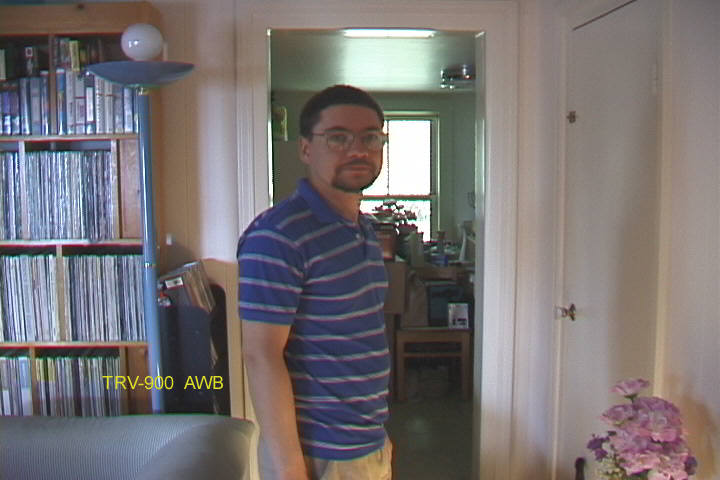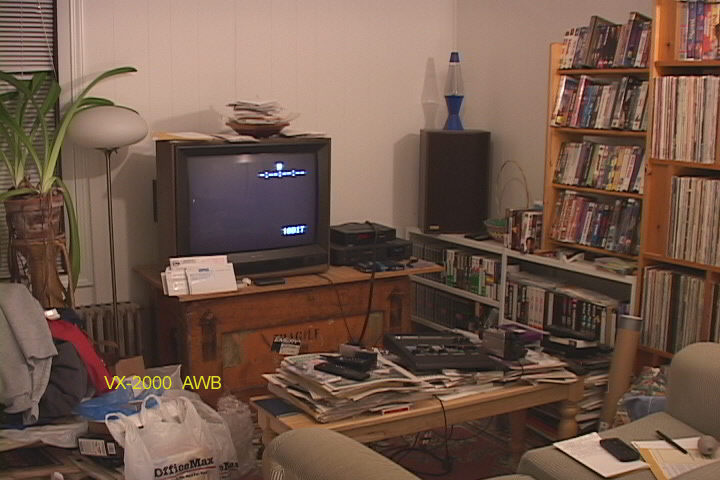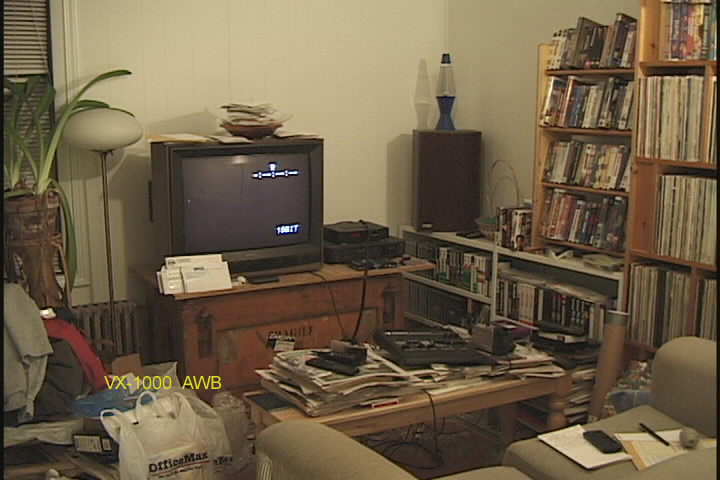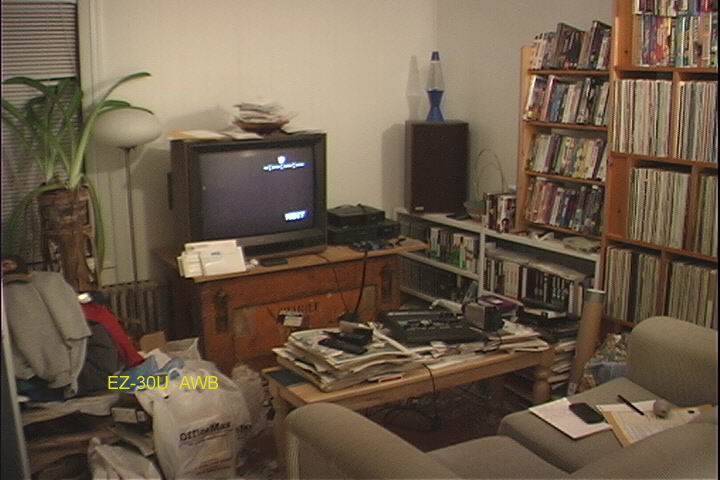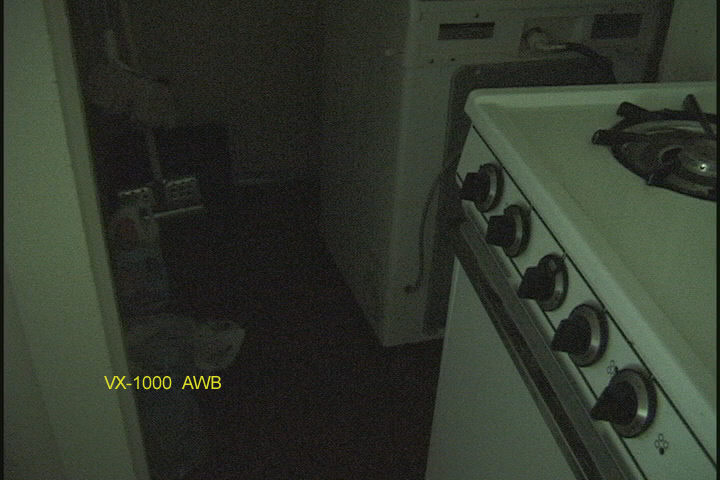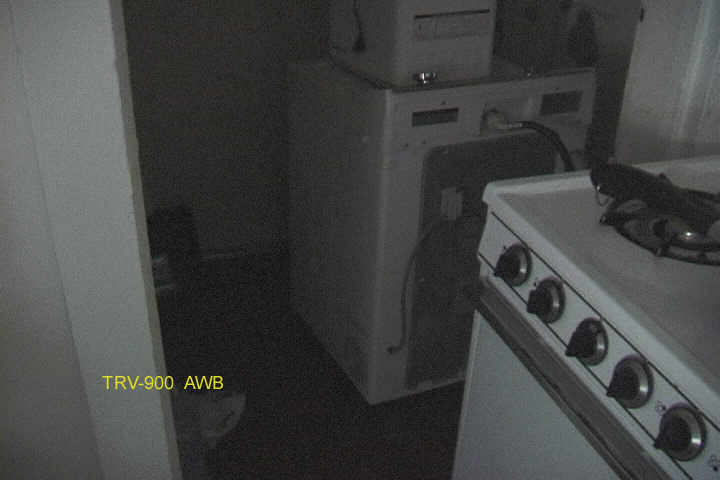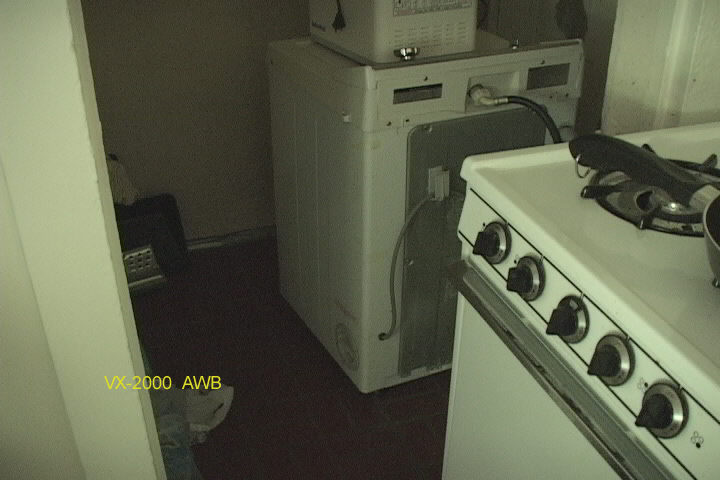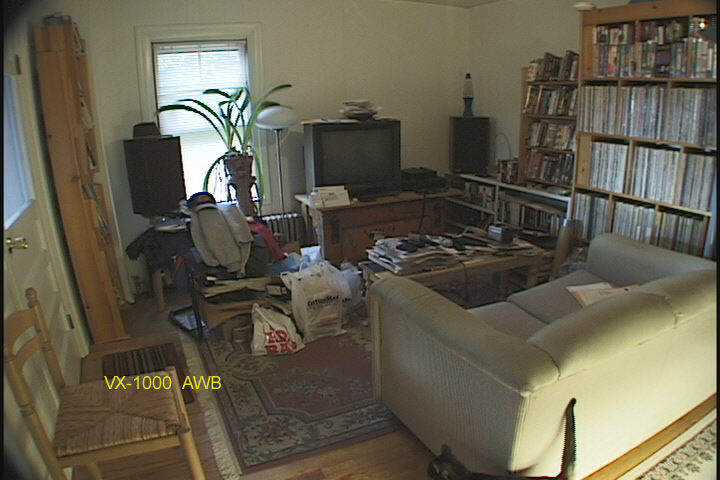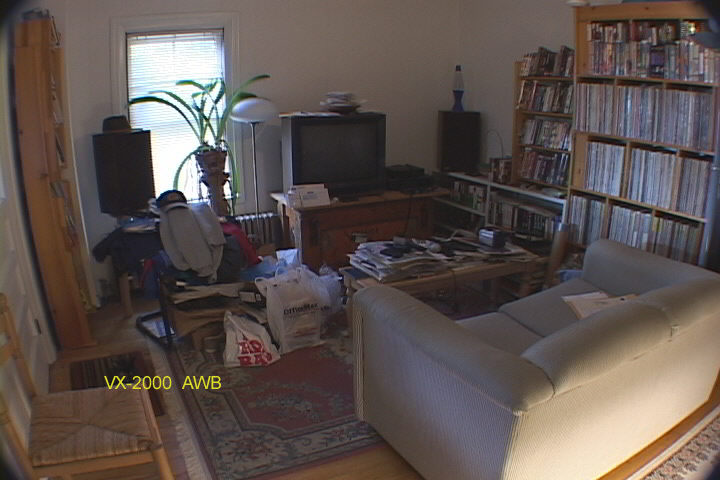|
>>> VX-2000
(Check below
for comments on the
similar PD-150;
for reviews of other Mini-DV
camcorders, go here;
for comparisons of various Sony Mini-DV camcorder *imaging types*, go here;
for comparisons of various WA lens converters that fit the VX-2000, go here;
for shades and other VX2000 odds-and-ends, go here.)
Well, OK, Sony's newest and bestest "pro-sumer"
Mini-DV camcorder, the VX-2000 (along with the similar VX-2100 and DVCam PD-150
and PD-170 and shoulder-mount DSR-250), has been out for quite a while now. The
following comments (updated from the original review, written soon after the
VX2000 was first available) are based on several years' experience with three
samples of the VX-2000:
The Picture:
(For
descriptions of various video picture characteristics, with examples, look here.)
--- It is very sharp (it is a tad sharper
overall, and noticeably sharper at
wide stops, than the TRV-900 and VX-1000, the next two sharpest Mini-DV
camcorders compared here and here). The image is so sharp
that detail appears to be at the pixel level, giving a slightly "busy" look as the camera is moved over finely-detailed subjects.
This is probably due to "mosquito noise" compression-effect or
aliasing, common
with the sharpest D25 video images. There is also some slight tendency to show "stair-stepping"
effects on near vertical lines in addition to the usual near horizontal lines (the Sony VX-2000, VX-1000, TRV-900; the Panasonic
AG-EZ30U; and the Canon XL-1 and GL-1 pictures all look different in this
respect - with the GL-1 being the worst, and the VX-1000 the best [it does not
use pixel-offset]),
but the noticeable sharpness gain with this camcorder is worth the additional picture
"busy" look. Sharpness is not gained with excessive
"sharpening" artifacts as it is with some other camcorders (mainly the
Canon XL-1 and GL-1) - and unless the
sharpness is raised considerably in the custom controls, contrasty edges do not
have excessive "halos" with the VX-2000. The picture of the VX-2000 is a full 720 pixels wide, unlike with the VX-1000, and
especially the GL-1 and XL-1 (these show black bands at the picture sides, making some
editing transitions and effects harder to use). The VX-2000 picture can show vertical lines with bright light sources
(no worse than with most others, somewhat better than with the VX-1000, and
much better than with some of the newer "HAD" megapixel one-CCD models), but judicious use of the two built-in ND filters
to slow the shutter speed can minimize this
effect. The lens by itself (and the lens with good WA converters attached) appears much better in back-light and
point-source lighting conditions than usual, with less flare and fewer internal reflections
showing - though on hard
edges with extreme brightness on one side, there does appear to be some image
bloom with the CCDs. The lens is sharp to the corners at all stops (see here
for stills shot with the VX2000 at all the available stops), though there is some corner
illumination roll-off toward the widest stops (most of it is outside the TV-safe
area and is normally hidden).
--- Exposures are closest to the TRV-900 - in stock form, the
camera overexposes exterior views slightly (AE gives a slightly too light picture, curable with the
AE-bias controls on the VX-2000 and TRV-900). Using the custom
controls, I get a picture very much to my liking. I prefer these CP adjustments
with my two NTSC VX-2000s for many subject types: for most exterior work, 0 for color level, +1 for sharpness,
+1 for color balance, and -1 for AE bias, with DWB selected (best color balance for exteriors
with most Sony NTSC Mini-DV camcorders is had with
"daylight white balance" selected - though this is not true for one PAL
VX-2000 I know of);
interiors generally look better to me with less warming and saturation dialed
in, with the AE-bias
returned to 0 (or whatever is needed to compensate for the predominant wall
tone), and with AWB used (fluorescent lights are very well handled by the VX-2000's
AWB). You can also limit gain rise with the CP controls to
+18db, +12db, and +6db (the picture is excellent through about +12db, though,
and it is still remarkably good, with little color noise and acceptable color,
at +18db). My original two VX-2000s matched in color
balance fairly well, with one warmer than the other in all WB modes by an amount
about equal to the color of a strong skylight filter (or about 1/2 the change
made by one increment of warming using the CP controls). My third VX2000 showed a
cooler color balance in DWB and in AWB in tungsten light (the latter was an
improvement). My
two VX-1000s happened to color-match better; my two TRV-900s, worse (nothing
bad, just slightly different).
--- The VX-2000 color
is the most natural-looking and free of color bias and tints that I have yet seen
in Mini-DV (with the appropriate color control settings used...). Familiar
colors (blue sky, foliage greens, skin-tones, neutral-color paving, etc.) can
look quite realistically rendered, and unlike with most other cameras, the
colors show little of the tinting of other colors mixed in (the color purity is
excellent) - and subtle colors are also well-rendered. (The Panasonic AG-DVX100
now offers some competition with a color balance that is a bit more neutral...)
--- The VX-2000 contrast is lower than that of the other 3-CCD Mini-DV
camcorders (and all the 1-CCD camcorders), except possibly the VX-1000. This
provides better tonality and shadow and highlight detail, easier exposure
determination, and a more "natural-looking", less "harsh"
picture. (The DVX100 now offers some competition here, with tonality that is
similar, and with controls for modifying it...) Even with the lower contrast, the blacks remain consistently good (and
better than those of the TRV-900 in some situations, though the TRV-900 picture
contrast is higher). Compared with the Canon 3-CCD camcorders and all 1-CCD
camcorders, the VX-2000 picture retains far more highlight detail and somewhat
more shadow detail when an overall "normal" picture exposure is given
to a scene with a wide-range of brightnesses. (The much-improved GL2 has
removed this shortcoming, though, and the DVX100 also offers "normal"
picture contrast - and adds useful controls over the tone response curve
shape...)
--- The VX-2000 is unusually good in low-light (an understatement!). It has
excellent color and very low noise in moderately low light, and the low-light limit is
far below
that of the other cameras tried. The image quality near the low-light limit is
also much higher than that of the other cameras tried (the difference here is "like night and
day"...;-). With the available slow shutter speeds, low noise and acceptable-looking
color at even +18db gain, and a lens that is good at wide stops, the VX-2000 can
produce acceptable-quality images in VERY low light levels. (Newer models have
narrowed the gap, but it remains...)
--- AF response appears slower than usual, reducing
the "hunting" effect
(though also reducing its ability to quickly shift focus). AF focus shifts look "smoother"
and more natural (more like good manual focus), with little or no "hunting" (though with swift motion in
some conditions AF may be left lagging, as would be manual focus also). Overall, AF is excellent, even in
fairly low light levels - in this it is noticeably better than all the other camcorders
tried (and I rarely use MF
anymore with this camera since the AF is so reliable).
--- The stabilizer appears
OK, with less "bouncing ball" effect at the short end of the zoom
range and "swimming" effects than usual with some other systems, but it is less effective than I would like in reducing
"jitter" with the lens zoomed long (this is my main
complaint with the VX-2000...). Various hand-holding aids help with this,
including side handles, bottom bars, belt pods, and shoulder pods (for more on
this, see "Handling", below). The
stabilizer works well when left on with tripod use, smoothing movements and
camera-handling disturbances - but the pan/tilt motions must be started/stopped
gradually to prevent image "backlash" motion (this is good practice,
anyway, with tripods with legs insufficiently sturdy to resist
"wind-up" and the resultant backlash).
--- Other things noted about the VX-2000 picture: under rare
conditions
banding can be seen on smooth gradient tones - and once I saw vertical
alternating red and blue lines, and another time vertical bars in a late evening
sky (but each of these effects has appeared only once); shooting thin,
"ropey" waterfalls, the vertical streams of water are sliced
diagonally in the VX-2000 picture (this may be helped by using slow shutter
speeds...); very bright pure red and orange back-lighted
flowers can show some "blooming" (but normal reds and oranges bloom
minimally, if at all); and, as noted earlier, there can be some spread of
bright areas in the picture (most often vertically, caused by CCD and shutter effects and
not lens flare). On the plus side, the CCD is unusually well
centered in my two samples (slightly less so in the third), making using WA converters that can vignette easier to deal
with; the picture is relatively freer of scan-line interference effects with
motion than most of the other Mini-DV camcorders I've tried, giving a
smoother-looking image with camera motion (the GL-1 and the megapixel 1-CCD
camcorders were the most annoying in this aspect, important to me).
--- The Canon WD-58 WA converter is an excellent match for
the VX-2000, and it is
about 1/2 the price of the Sony VCL-0758HG WA converter, but both are only .7X (the Sony
non-zoom-through .6X VCL-ES06 can be fitted with a 58->52mm step-down ring
for noticeably greater width of view without vignetting in the TV-safe area) - see frame-grabs below.
The Raynox HD6600-58 .66X is an unusually low-distortion converter that is light, inexpensive, and
excellent for wide-angle views,
but it
loses some sharpness as the lens is zoomed toward the long end, and it shows more flare than the Canon
and Sony converters (see shade options here,
along with some other odds-and-ends for the VX2000). One fisheye of the many I have
(a Sakar Series VII, the older heavy black one with the close-up lens built-in) works well when left with
an image that is circular short the top and bottom cut-off. I tried the
Raynox .3X full-frame fisheye converter on the VX-2000 and was disappointed -
sharpness at the edges and corners was so-so, and color fringing on contrasty
edges was very noticeable. The .24X DCR-FE180 Raynox fisheye is excellent,
though, but rather expensive, heavy, and large. Several 52mm-thread
achromats and simple close-up lenses work very well on the VX-2000 using 58->52mm
step-down rings. The 58mm lens
thread unfortunately makes mounting many common lens attachments impossible,
though. I'm
still looking for a sharp, low-distortion, non-vignetting zoom-through .5X WA
converter. For a comparison of several zoom-through
and fisheye converters for the VX-2000 (with frame-grabs), look here.
Even with the faults noted above, the picture quality
of the VX2000 is very satisfying
(kind of an understatement...;-). It is the best yet overall that I have seen
in D25.
The Sound:
---
The built-in mic has unusually
low sensitivity to wind - and adding a couple of
layers of air-conditioning filter foam (or a Radio Shack 33-373A wind screen) improves this, making this one
of the
VERY few
camcorders that can be used in moderate wind without using an external mic (see
the picture and instructions here
for the home-made windscreen, look here
for a picture of the RS windscreen). The
built-in mic has a slightly bright (but pleasant) "presence-peaked"
sound for good voice intelligibility (though it is also excellent for general
ambience recording, and it is even acceptable for some types of music recording)
- and it offers a good, wide stereo sound "image". The built-in mic
appears to have unusually low gain
compared with several external mics tried. The result is that audio input levels are
unusual and this makes adding most mics with the AGC switched on more difficult (excessive
limiting ruins the sound with several popular mics unless an appropriate
attenuating pad is use in line with the mic). Switching to manual gain works with
external mics (preferably higher-sensitivity ones, since lower sensitivity mics
mismatch the manual input gain for lowest noise), and the VF audio-level meter
makes it (sometimes...) easy to keep track of manual audio-gain needs. A mic pad
can be added to better match the gain needs of the excellent AGC, which is usually my
preference. The AGC
is unusually good in that it retains more than usual dynamic range and it does
it with minimal artifacting compared with others - it sounds like good manual
gain-riding, and its effects are rarely noticeable unless conditions are
extreme. I was able to hear
excessive noise (and "popcorn" noise, in addition to
"hiss") in manual mode when input and output gains were set incorrectly
(especially when monitoring with an unloaded input, or one with mismatched mic
sensitivity, through the noisy and high-end-peaked headphone amp
with headphones with the usual top-end roughness and peaking), but in
normal use (with peaks just below clipping, monitoring line-out) I have not heard
excessive background noise levels in two samples of the VX-2000. In fact, in general, the noise-level is quite low with
this camcorder - in a quiet room, there appears to
be no pickup of camera motor sound, unlike with the other camcorders tried (though
motor-noise pick-up with most of the other 3-chip models was minimal). The
"hiss" level was barely audible at normal record levels,
checked at the line outputs with normal playback levels and with gains properly
matched at the inputs. As with all other
consumer/"prosumer" video cameras, the VX-2000 unfortunately does not
deliver anywhere near the
full dynamic range the 16-bit audio format is capable of, but the range is
satisfactory for most video sound purposes and similar to that offered by
other camcorders near its price level (the "hiss" levels of the VX-2000 and
TRV-900 matched closely with either their built-in mics used or with the
same-model external mics connected, turned on or off, in
both manual-level and AGC modes). For critical recordings requiring
unusually high dynamic range, the use of a high-quality external recording
device may be preferable; for most other purposes, when its quirks are
properly accommodated, the sound recording ability
of the VX-2000 is very good. I did hear recorded the noise of
releasing the start/stop button on one of my VX-2000s (adding a small rubber center blob on it
prevented the button from
sticking to my finger during release, which cured this problem). There is also some low-frequency pickup of mechanical vibration from the transport mechanism
with some external mics (the popular Sennheiser MKE-300, especially), and this noise
can be easily mistaken for hum. In general, the recorded sound
using the built-in stereo mic is excellent (when ambience pick-up is desired), with very little background noise and AGC
ill-effects, but the overall level is a bit lower than average (to accommodate
relatively higher peaks than
is usual with AGC). An external camera-mounted short-shotgun mic or off-camera
shotgun or lavaliere mic would be more suitable for some purposes than the
built-in nearly-omnidirectional camera mic. There is also a mic/line-level switch at the mic input jack,
unusual for this level of camcorder.
Overall, the sound
quality of the VX2000 is very good, but it is not without some quirks that
complicate adding external mics - the Canon XL-1 and PD150 win here,
though, for their versatility, general sound quality, and controls (though with
reservations about the XL-1's lens controls and image quality compared with some
others).
The Handling:
---
The VX-2000 is fairly large and heavy as
compact "handycam"-style camcorders
go (though it is very noticeably smaller and lighter than some other Mini-DV
camcorders, like the Canon XL-1 and the shoulder-mount JVC DV500),
and it is therefore harder to pack in normal-sized camera bags than most others.
I also have more difficulty holding the VX-2000 steady with the lens zoomed long
than I do with the other camcorders, even the similarly-shaped VX-1000. Putting
a side handle on the VX-2000 (a still-camera flash-bracket) helps (I use these
handles with most camcorders), but I find it necessary to add an additional
steadying aid for good long-lens
video, something unnecessary with the other camcorders tried (including the EZ30U,
without stabilizer). A belt-pod, a monopod placed over a shoulder, and a modified "Habbycam"
shoulder-brace
have helped.
More recently, I found that attaching a straight bar to the bottom of the camera that extends out to
the left far enough to rest on the top of my left arm (with the left hand
holding the focus ring, or the "blob" under and behind the
front of the lens, and with the right hand under the strap on the right of the
camera) helps steady the camera quite well, and it is simple, compact, and easy
to pack.
--- The zoom ring is hard for me to control for smooth long-range zooms - but
it is excellent for smooth starts and stops for shorter-range zooms. The rocker zoom
control appears better than those on other Sony camcorders, and it is easy to control
zoom speeds with it, but it has the usual
abrupt starts and stops. I found that the zoom control on a small remote control made for the
TR65 Hi-8 camera zooms the VX-2000 lens only at its slowest rate, a useful
thing to have. The old Sony Lanc pistol-grip controller zooms the lens at a
usually-too-fast medium speed. There are Lanc controllers made by Canon and
others that also serve well when the camera is tripod-mounted (and they offer
more range of zooming speed), but some tend to be expensive, and none starts and
stops the zooming gradually. My favorite Lanc
controllers are the Canon (it provides five fixed zoom speeds in addition
to variable speeds - but it cannot power-up the camera or recover it from
standby mode, and it is hard to control zoom speed with the rocker), the Sony remote removed from the cheapest Sony tripod
that comes with a
remote (it can do all but fixed zoom rates, and has lighted buttons), and the Sony RM-95
wired remote (it has only one
medium zoom rate, but it can also switch on/off AF and allow manual control of camera
focus - and it shows the tape timecode), but I'm still looking for a Lanc
controller that can start and stop the zoom smoothly with the VX-2000.
--- The large manual-focus ring is
nice (but AF is so good on this camcorder that I now rarely use it - but when I
do, the "momentary AF" button can also be useful).
--- The built-in two different-density ND filters
(1/4 and 1/32) make control of DOF and auto-mode shutter speed easier than on most consumer-level
camcorders (though the shutter speeds can be limited to 1/60th - 1/250th by
turning "auto-shutter" off, which can be advisable in bright light to reduce
strobing during motion and the vertical smearing of bright lights).
--- Battery placement is good, and the largest available batteries fit (a welcome
addition!) and they do not interfere with viewfinder use. As usual, the indicated
battery run-times in the specs and in the viewfinder display have little to do
with reality - but the run-times are so much longer with the medium and large
size Li-ion batteries than we were used to with the old NiCad batteries, who
cares...?;-) The battery run-times possible with this camera are astonishing -
Sony has solved the power-supply problem with this and other recent camcorder
models. I no longer carry AC-connected supplies on location, since even one
compact/light/inexpensive battery will run the camera for several hours! There is no external battery charger with the VX-2000 (batteries
are charged only internally using the supplied charger), so unless you spring for
the accessory external charger, or already have another one (supplied with some
older Sony Mini-DV camcorders - I use my TRV-9 charger), battery-charging can be
awkward. But with a few fully-charged light/small NPF960s handy, one is just
about ready to cover an extended expedition without needing to recharge
batteries! ;-) .
--- The eyepiece viewfinder is good, especially when used with the
excellent supplied large eyecup,
which also accommodates glasses well. It fits so well, though, that
glasses-steaming is a regular hazard with the big VX-2000 eyecup, unlike with
the similar one made for the VX-1000 - but I punched four holes in it, which cured
this problem (see a picture, here). The magnification was higher, the eyepiece
larger, and the off-axis view better on the VX-1000 viewfinder - and the color could be
dialed out for a slightly easier-to-focus B&W image. The 500-line B&W
PD150 is even better, but with the excellent AF available, a sharp VF is less
essential. The VF image mysteriously
occasionally blinks on my two VX-2000 samples. The little fold-out viewing
screen has some occasional uses, but it is too hard to see in bright light to be
of much use for most exterior work, even when hooded. I do find this panel
finder very useful for interior
tripod work, though. A useful VF feature is included: a
rectangle in the VF (which can be switched on/off) that can be used as a guide
for aligning the camcorder with horizontal and vertical subject lines. With the
VF color and brightness levels matched to a good monitor, the VFs can serve as
fairly good guides for evaluating exposure and color balance when their
"quirks" are learned.
--- There are several "hokey" features brought over from the
TRV-900 to the VX-2000, giving it (along with its bright silver color) a
"consumer" look and feel undeserved by its overall excellent picture
and sound capability: function "chimes" (which can be made
"beeps", or turned off); useless AE modes (though AE-A
with selected aperture, combined with AE bias-adjustment and sometimes a ND
filter to prevent high-speed shutter negative effects, is very useful to me);
useless "special effects" (with the exception of B&W mode...); and
the silly on-tape still-photo feature (for stills, any much smaller, sharper, lighter,
cheaper still digital camera will produce better results, without spoiling video
footage with freeze-framing or "progressive-scan") -
but these features can be ignored, along with the hard on the tape-loading
mechanism
time-lapse ability. The VX-2000 "progressive-scan"
mode video footage looks terrible, since it is optimized for still-use only -
but see below for a partial recanting of my earlier view that video-camera
stills are useless (when the "Memory
Stick" is used to record the still images). The VX-2000 does have some nice features brought over from
the TRV-900 or VX-1000, or added new: color bars; analogue-to-DV transcoding
(without having to record analogue footage onto Mini-DV tape first); LP-mode
recording; 16-bit 48KHz sound recording; line-level recording ability; VF sound-level
meter; VF alignment-guide rectangle; two levels of VF highlight overexposure indication
(zebra stripes);
and the "manual" zoom ring (it is servo-type, but it almost feels
"real"...;-).
Handling the VX-2000 is fairly
pleasant, but some controls are still hard to find and awkward to
use - I find
the EZ30U the easiest to carry, pack, and handle of the camcorders in
this group (though its controls and low-light ability are very limited).
The Auto-Controls:
--- The VX-2000 has
introduced a practical new concept of camera control to video: automatic control
of exposure, focus, white balance, and sound level (with bias controls provided
for most of these to permit shifting the control centers away from the factory
presets) that is good enough to challenge even the experienced operator to
improve on the results with manual operation. With use
of this camera, I quickly
shifted from manual operation to the use of the auto controls when I realized
their potential (with exposure-bias, hue-bias, saturation-level, and
sharpness-level set to optimize results in particular environments), but it took
me a while to realize what this meant. In still photography, I was one of the
last "hold-outs" of manual control of exposure and focus, while
virtually all other photographers (both amateur and pro) had switched to using
automatic controls (with bias controls used, when appropriate) on their 35mm
cameras for almost all types of work (and even roll-film cameras were becoming
automatic-capable). An eye problem, and the eventual appearance on the market of
sufficiently well-designed automatic still gear finally led me to understand
that good automatic controls could be relied on for producing top-quality
results, and I recently joined most other small-camera still photographers in their use
of automatic camera controls. In video in the immediate past, amateur video was
most often shot in full-auto mode (and the small cameras used generally provided
few other options); pro video was most often shot in full-manual mode, using
large, heavy cameras with excellent manual controls, but with few automatic
features (and those provided were generally rudimentary). As the image and sound
quality of new Mini-DV/DVCam format became known and some pro work began to be
done in that format, it was reasonable (and appropriate, given the level of gear
available) for pros to try to continue using manual operation with these new
small cameras (difficult as that was, given the limitations of the controls), though they were obviously designed to be used most
often in automatic-mode (in manual-mode, apertures shifted in large increments
instead of smoothly, focus and zoom control were servo-operated, removing good
"feel" and precision from their operation, and manual audio level
control was close to impossible, given the relatively low peak
"headroom" in Mini-DV and poor monitoring facilities).
With the appearance of the VX-2000, the performance level of the automatic
controls (with the bias controls used when appropriate) has reached the point
where one can use them with confidence that the results on tape will about
equal, or even surpass, the results using good manual controls under most conditions.
This makes camera operation considerably easier and faster, and opens new possibilities for
what can be successfully video taped.
The capability of the VX-2000
automatic controls (used with appropriate bias-adjusts) surpasses those of all
the other cameras I've tried by a noticeable margin, and the VX-2000 is the
first camera that is truly reliable when used in automatic mode in most shooting
conditions.
The Conclusion...
Nothing is perfect,
and I prefer other camcorders for particular strengths, but overall, the VX-2000
is the best yet that I have tried - this camcorder is
purdy durn gud, and it is easily the most capable and versatile of the small
automatic-control Mini-DV camcorders for most shooting purposes.
Since writing the above, a new
generation of "handycam"-style camcorders has appeared to challenge
the VX-2000/PD-150, including the Canon GL-2, the Panasonic DVX-100, the JVC
DV-GY300, the Sony TRV-950, and the virtually identical to the VX-2000 Sony
VX-2100. From all appearances from other tests and reviews (and a
quick look at the DVX-100 and GL-2), the overall picture quality of these in good light
has come closer to that of the VX-2000/2100/PD-150/170, but with the VX2000 and
similar generally still holding the lead
by a tad compared with the others in good light with slightly better
detail-rendering and with less oversharpening - and the VX2000 still has
superior
very low light imaging quality. Notes on some of these newer cameras have been
added to the review, when appropriate...
>>> PD-150
From a brief encounter with the PD-150:
The PD-150 is similar to the
VX-2000 in appearance and operation (and the VX-2000 comments above apply to the
PD-150), with the following exceptions:
- The PD-150 accepts small DVCam as well as Mini-DV tapes (it can record
in Mini-DV
SP-mode, or in DVCam mode on either tape type, but it does not
record in Mini-DV LP-mode).
- The VF is a high-resolution B&W LCD type, making manual-focus noticeably
easier (though the
VF image appears no larger than the one in the VX-2000).
- The sound capability has been expanded with XLR connectors (no
mini-jacks, though), phantom
power, independently adjustable stereo channel
levels, individual-channel metering, and external
switching.
- Instead of "AE-A" and "AE-S" modes, the PD150 allows
direct switch-selection of independently
adjustable aperture, shutter speed, and
gain (the result, though, is that "lock-and-shift" exposure
control is
more complex than it is with the single-button select on the VX-2000 - it
requires
individually locking down all the variables).
- The removable mic supplied is a mono short-shotgun type.
- The PD-150 comes in a dark grey color instead of the darkish-silver
color of the VX-2000.
- The menu select button is inside the LCD panel door, instead of on the rear as
with the VX-2000.
Most of the
controls appear similar to the ones on the VX-2000, but some of their functions
are different (this could be a source of confusion when using both camcorders).
The viewfinder display is more "cluttered" than it is in the VX-2000,
but the information display can be turned off for a clear view of the VF screen.
Almost $1000 more expensive than the VX-2000, one gains a bit more control, XLR
inputs, and a few other goodies, but one loses a good built-in stereo mic and a
bit in easy functionality - and one gains fairly little in real capability. The
VX-2000 and PD-150 have outstanding auto functions, and the slightly more
extensive manual control offered by the PD-150 may therefore not be of much
value to many users - though the XLR audio connectors (with phantom power) and
the additional audio control would be of value to some users. Overall, the
PD-150 occupies an interesting position between the amateur-oriented VX-2000 and
the pro-oriented DSR-250, and all three share the same basic excellent imaging capability.
The VX-2000/PD-150 Still-Capability Revisited...
I after trying out the
low-res. (640x480) still-photo capability of the VX-2000, I was a bit
surprised by how easy it is to use, and by how good the images can look (for
screen-use only - there is insufficient resolution for making good paper-prints
from these unless they are small [4"x5" or so...]). BTW, most of the
images in the "For Sale" section of this web site (www.David-Ruether-Photography.com/fs.htm)
were shot with the
VX2000. The tiny Memory Stick fits into the camera easily, and
picture-taking is as easy as pressing the small silver "shutter
release" while in still-photo mode. Even though the PS-mode images are 1/15th second, I had no
trouble getting sharp images hand-held with the lens zoomed long. There is even
a separate set of "custom controls" for picture characteristics
available for stills, so you can optimize settings for stills without upsetting
the custom-control settings for motion-video. Getting the
images into the computer with the supplied USB reader is easy and fast. I
have ranted long and often about this silly feature on video cameras, but I
found myself liking it on the VX-2000 for some purposes.
|





